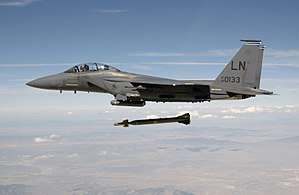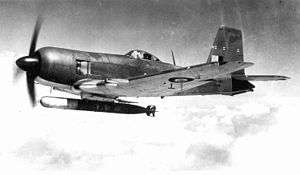Strike fighter
In current military parlance, a strike fighter is a multirole combat aircraft designed to operate both as an attack aircraft and as an air superiority fighter. As a category, it is distinct from fighter-bombers. It is closely related to the concept of interdictor aircraft, but it puts more emphasis on aerial combat capabilities as a multirole combat aircraft. Examples of contemporary American strike fighters are the McDonnell Douglas F-15E Strike Eagle, Boeing F/A-18E/F Super Hornet, and Lockheed Martin F-35 Lightning II.

History

Beginning in the 1940s, the term "strike fighter" was occasionally used in navies to refer to fighter aircraft capable of performing air-to-surface strikes, such as the Westland Wyvern,[1] Blackburn Firebrand[2] and Blackburn Firecrest.
The term "light weight tactical strike fighter (LWTSF)" was used to describe the aircraft to meet the December 1953 NATO specification NBMR-1.[3] Amongst the designs submitted to the competition were the Aerfer Sagittario 2, Breguet Br.1001 Taon, Dassault Étendard VI, Fiat G.91 and Sud-Est Baroudeur.
The term entered normal use in the United States Navy[4] by the end of the 1970s, becoming the official[5] description of the new McDonnell Douglas F/A-18 Hornet. In 1983, the U.S. Navy even renamed each existing Fighter Attack Squadron to Strike Fighter Squadron to emphasize[6] the air-to-surface mission (as the "Fighter Attack" designation was confused with the "Fighter" designation, which flew pure air-to-air missions).
This name quickly spread to non-maritime use. When the F-15E Strike Eagle came into service, it was originally called a "dual role fighter",[7] but it instead quickly became known as a "strike fighter".
Joint Strike Fighter
In 1995, the U.S. military's Joint Advanced Strike Technology program changed its name to the Joint Strike Fighter program.[8] The project consequently resulted in the development of the F-35 Lightning II family of fifth generation multirole fighters to perform ground attack, reconnaissance, and air defense missions with stealth capability.
Modern strike fighters
- McDonnell Douglas F-15E Strike Eagle
- Boeing F/A-18E/F Super Hornet
- Lockheed Martin F-35 Lightning II
- Shenyang J-15S
- Shenyang J-16
- Sukhoi Su-30MKK
- Sukhoi Su-34
See also
References
Citations
- "Aerospace Engineering, Volume 6." Institute of the Aerospace Sciences, 1947.
- The Aeroplane: Volume 75, 1948.
- Angelucci, Enzo; Matricardi, Paolo (1980). Combat Aircraft 1945–1960. Maidenhead: Sampson Low Guides. p. 273. ISBN 0-562-00136-0.
- "Inside story of the troubled F/A-18." Popular Science, Volume 223, Issue 4, October 1983. ISSN 0161-7370. Retrieved: 23 December 2011. Quote: ... can fly either as a fighter or an attack plane [...] In Navy parlance, it is a strike fighter.
- "The FY 1981 military programs." Bulletin of the Atomic Scientists, Volume 36, Issue 6, June 1980, p. 38. ISSN 0096-3402. Retrieved: 23 December 2011.
- Polmar 1997, p. 343.
- Defence Update (International), Issues 79–84, p. 43.
- "Joint Strike Fighter (JSF)." globalsecurity.org. Retrieved: 2 February 2011.
Bibliography
- Polmar, Norman. The Naval Institute Guide to the Ships and Aircraft of the U.S. Fleet. Annapolis, Maryland: Naval Institute Press, 1997. ISBN 978-1-59114-685-8.